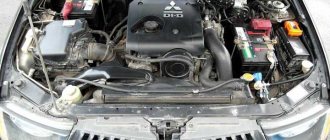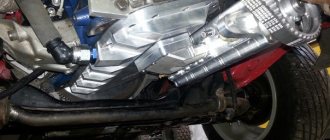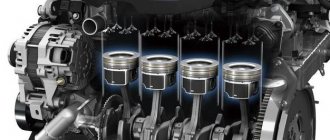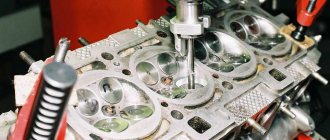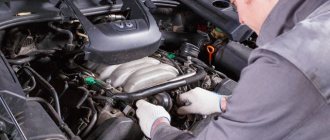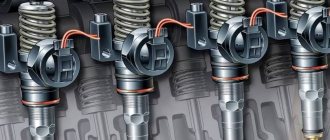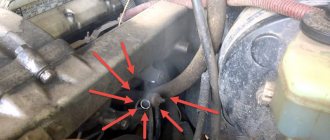- home
- /
- Articles
- /
- Diesel engine: design and operating features
Every year more and more drivers are choosing diesel cars. They have lower fuel consumption, are cheaper to operate and have a long service life. But those who encounter this type of engine for the first time may have a number of questions. So, how does a diesel engine work, what features does it have and are there any disadvantages?!
Design and operation of a diesel engine
A diesel engine is a piston internal combustion engine. The principle of its operation is based on the fact that the fuel ignites spontaneously due to the supply of compressed air. Its design is practically no different from a gasoline power unit. The only exception is that a diesel engine does not have an ignition system: the fuel mixture is ignited not by a spark, but by high pressure. It compresses the air, causing it to become very hot and ignite the fuel mixture.
For many decades, diesel engines have been installed in special equipment and trucks, as well as passenger cars. If earlier such an engine had a number of disadvantages, today there are special additives and devices that “warm up” the fuel mixture, thanks to which the car starts without problems even at -30.
There are currently several types of diesel fuel. This can be rapeseed oil, pure or refined oil, friction substances, etc.
History of creation and improvement
The first scientific developments regarding the possibility of using fuel compressed to high pressure to ignite fuel in a heat engine were carried out in the 20-30s of the 19th century. In practice, this principle was implemented by the outstanding German inventor and engineer Rudolf Diesel, who in 1892 filed a patent for the invention of an engine of an original design, called a diesel engine in honor of its creator. After 3 years, the document was recognized by the United States. Over the course of several years, Diesel registered several more patents for various modifications of the diesel engine.
The first working unit was manufactured at the end of 1896, and its tests took place almost immediately - on January 28 of the following year. The first diesel engines used vegetable oils and light petroleum products as fuel. The power plant almost immediately began to show high efficiency, while also being very convenient to use. But in the first years after their invention, diesel engines were used mainly in heavy steam engines.
Two key improvements have made it possible to significantly expand the scope of practical use of diesel units. The first was the use of kerosene as a fuel, which was first used in 1898 by another great engineer of that time, the Russian-born Swede Rudolf Nobel. The second major rationalization decision was the invention of a high-pressure fuel pump (HPFP), which replaced the compressor previously used to compress fuel.
Robert Bosch made a serious contribution to improvements in fuel injection pumps in the 20s of the 20th century. He invented and introduced a model of a built-in pump and a compressorless nozzle, the use of which led to a significant reduction in the dimensions of the diesel engine, which, in turn, made it possible to install it first on public and freight transport, and in the second half of the 30s - for the first time to use it on passenger cars cars. Further improvements to the unit in question, in particular the use of special diesel fuel, allowed the power plant using this type of fuel to successfully compete with gasoline engines, constantly increasing its market share.
Operating principle of a diesel engine
The operating principle of a diesel engine is based on compression ignition of fuel. It enters the combustion chamber, where it begins to mix with hot air. The operation of the engine itself depends on the amount of air and other features.
The fuel assemblies are supplied separately: first, air is supplied, which during compression is heated to 700-900 degrees. After this, fuel is supplied at high pressure up to 30 (MPa). All this mixes and ignites, thanks to which the engine starts.
During ignition of the fuel-air mass, increased noise and strong vibrations may occur. But they do not create much discomfort.
Design and structure
The design of a diesel engine is no different from a gasoline engine - the same cylinders, pistons, connecting rods. True, the valve parts are reinforced to withstand high loads - after all, the compression ratio of a diesel engine is much higher (19-24 units versus 9-11 for a gasoline engine). This explains the large weight and dimensions of a diesel engine compared to a gasoline engine. The fundamental difference is in the methods of forming a mixture of fuel and air, its ignition and combustion. In a gasoline engine, the mixture is formed in the intake system, and in the cylinder it is ignited by a spark from the spark plug. In a diesel engine, fuel and air are supplied separately .
First, air enters the cylinders. At the end of the compression stroke, when it is heated to a temperature of 700-800 ° C, diesel fuel is injected into the combustion chamber by nozzles under high pressure and almost instantly ignites spontaneously. Mixture formation in diesel engines occurs in a very short period of time. To obtain a combustible mixture capable of quickly and completely burning, it is necessary that the fuel be atomized into the smallest particles possible, and each particle has a sufficient amount of air for complete combustion. For this purpose, fuel is injected into the cylinder by a nozzle under a pressure several times higher than the air pressure during the compression stroke in the combustion chamber.
Diesel engines use undivided combustion chambers. They represent a single volume limited by the piston bottom 3 and the surfaces of the cylinder head and walls. For better mixing of fuel with air, the shape of the undivided combustion chamber is adapted to the shape of the fuel torches. Recess 1, made in the bottom of the piston, helps create a vortex movement of air.
Finely atomized fuel is injected from injector 2 through several holes directed to specific recess locations. In order for the fuel to burn completely and the diesel engine to have the best power and economic performance, fuel must be injected into the cylinder before the piston reaches TDC.
Self-ignition is accompanied by a sharp increase in pressure - hence the increased noise and harshness of operation. This organization of the work process allows you to work on very lean mixtures, which determines high efficiency. Environmental characteristics are also better - when running on lean mixtures, emissions of harmful substances are lower than with gasoline engines.
Disadvantages include increased noise and vibration, less power, difficulties with cold starts, problems with winter diesel fuel. With modern diesel engines, these problems are not so obvious.
Diesel fuel must meet certain requirements. The main indicators of fuel quality are purity, low viscosity, low auto-ignition temperature, high cetane number (not lower than 40). The higher the cetane number, the shorter the auto-ignition delay period after it is injected into the cylinder and the engine runs smoother (without knocking).
Diesel engine operating procedure
A diesel internal combustion engine can have 2 or 4 power strokes:
- inlet or suction. At this stage, air enters the cylinder through the open intake valve;
- compression. Under the action of the piston, the air that enters the cylinder is compressed several times, and its temperature increases to 800-00 degrees;
- working stroke. The gases generated during combustion move the plunger down;
- release or working stroke. The crankshaft rotates 540-720 degrees from its original position, the cylinder moves down, and the exhaust gases move down.
Many modern cars and trucks are equipped with a four-stroke engine.
Additional engine components
There are other parts in the design of a diesel engine. For example, a turbine. Many engines are equipped with turbocharging to increase power. Ordinary atmospheric engines do not have such a device.
Let's look at what turbocharging is and what it consists of.
Turbine operating principle
A large amount of air is supplied to the cylinders through turbocharging. The fuel supply during the operating cycle also increases. All this allows you to increase engine power.
Since the pump pressure in a diesel engine is higher and constant, this helps to avoid turbochargers, which are often present in a gasoline engine. Which owners of gasoline turbo engines are also often dissatisfied with.
The operating principle of the turbine is as follows:
- The exhaust gases pass through the compressor.
- They gradually spin the turbine wheel.
- Then the rotation of the turbine wheel is transferred to the compressor wheel. This is because they are both mounted on the same shaft.
- Under the influence of rotation, the turbocharger compresses the air. Then the latter enters the intercooler.
- Here it begins to cool. Then it goes back into the cylinders of the power unit.
This is how the turbine device works. The diesel engine starts even at subzero ambient temperatures. Glow plugs heat the air mixture to 900 degrees. That is why cold air masses can enter the cylinders through the turbines.
Turbocharging, also known as a turbocharger, consists of
Turbocharging of diesel engines consists of the following components:
- air intake;
- compressor;
- valve for regulating exhaust gases;
- throttle valve;
- filter device;
- intercooler for cooling air masses;
- pressure sensors;
- intake manifold;
- connecting tubes.
In turn, the turbine includes the following elements:
- bearings that create its rotation;
- turbine cover;
- compressor cover;
- steel mesh.
There are different types of turbochargers and their features. For example, in a variable geometry turbine, a modified cross-section of the inlet valve regulates the flow of exhaust gases. Two compressors are installed in series so that one device is responsible for each operating mode, and not two for all or one for all operating modes.
If the compressors in the engine are installed in parallel, then the turbo lags become barely noticeable. Mechanical and automatic turbocharging, installed together, contribute to increased power. For example, the first one turns on at low speeds, and the second one at high speeds.
Turbocharging cycle
Now you know what turbocharging is and how it works. Let's see what his cycle is.
- The turbocharger creates a vacuum. Air masses are sucked inside the turbocharger.
- Then the rotors come into operation.
- The intercooler cools the air masses.
- The intake manifold allows cold air to flow through it. But before it gets into it, the air masses are cleaned through air filtering devices.
- When enough air has been drawn in, the valve will close.
- The already exhausted air masses pass into the turbine of the internal combustion power unit and put pressure on the rotor.
- The rotation speed of the turbine itself and its shaft increases to 1500 rpm.
Thus, due to all these actions, pressure is generated, which increases the power of the diesel engine.
Similar article Characteristics and cost of the Toyota Surf contract engine
Intercooler and injector
The intercooler for a diesel engine was created so as not to subject engine parts to daily repairs. When exposed to high temperatures, engine parts are subject to rapid wear. To prevent this from happening, intercoolers were created.
The fuel supplied through the injectors is distributed correctly and in the right quantity. Therefore, detonation does not occur when the feed angle is correctly positioned.
Type of diesel internal combustion engines
There are three main types of diesel engine:
- with a divided combustion chamber. In it, fuel is supplied to an additional chamber. Air enters the vortex chamber and is compressed, which improves the combustion process of the fuel;
- with an undivided combustion chamber. This engine is distinguished by its efficiency, but at the same time it has a high noise level, which can cause some discomfort for the driver and passengers;
- prechamber motor. Such an internal combustion engine is equipped with an inserted prechamber. It is connected to the cylinder using thin valves. It is the shape and size of the channels that determines the speed of movement of gases during the combustion of heavy fuel. This type of engine is distinguished by the fact that it has a low noise level and toxicity, which allows to increase its service life.
The last option is the most popular. While driving, it does not create unnecessary noise, so nothing distracts you.
Diesel engine operating system
The main component of any engine is its fuel system. Its main task is the timely supply of fuel. Moreover, it must have a certain pressure and temperature. If these two rules are not followed, the car simply will not start.
The main elements of a diesel engine are the following elements:
- fuel pump;
- filter;
- injectors.
Let's take a closer look at each of these elements.
Fuel pump
It is responsible for supplying fuel to the injectors. Modern engines are equipped with two types of fuel pumps: in-line and distribution.
Fuel filter
The filter is one of the most important elements of any engine. It cleans the fuel mixture of debris, various particles and excess air that may enter the system. The filter is selected according to the car model.
Injectors
Injectors also play an important role in the fuel system. They are responsible for the timely supply of fuel, so the performance and service life of the engine itself depend on their reliability.
Diesel internal combustion engines use 2 types of injectors:
- with distributor;
- with font distributor.
The nozzle distributor determines the intensity and shape of the torch and is responsible for the timeliness and intensity of the fire.
How does the launch happen?
Cold start of the diesel engine is ensured by a pre-heating system. Electric heating elements - glow plugs - are inserted into the combustion chambers. When the ignition is turned on, the spark plugs heat up to 800-900°C in a few seconds, thereby heating the air in the combustion chamber and facilitating self-ignition of the fuel. A control lamp indicates the operation of the system to the driver in the cabin. The extinguishing of the control lamp indicates readiness to start. The power supply from the spark plug is removed automatically, but not immediately, but 15-25 seconds after starting, to ensure stable operation of a cold engine. Modern pre-heating systems ensure easy starting of a working diesel engine up to a temperature of 25-30°C, of course, subject to the oil and diesel fuel season.
Advantages and disadvantages of a diesel engine
Separately, I would like to consider the advantages of the diesel engine. These include the following points:
- low fuel consumption. Diesel engines consume approximately 30-40% less fuel than gasoline internal combustion engines;
- long service life. Diesel units are the most reliable engines in the world. Many of them easily overcome the mark of 700-800 thousand kilometers;
- excellent acceleration and excellent traction. Diesel engines are distinguished by high torque, which allows the car to confidently accelerate at any speed;
- low level of toxicity. There is a myth that diesel is highly toxic. But this was before, since modern fuel processing systems reduce the amount of harmful substances to a minimum;
- high efficiency. Diesel fuel burns with great efficiency.
But, despite the obvious advantages of diesel engines, it also has minor disadvantages. These include long warm-up periods in cold weather. Since the diesel unit has minimal fuel consumption and high efficiency, it needs more time to warm up.
Intercooler
It was noticed that if cold air is used during mixture formation, engine efficiency increases to 20%. This discovery led to the development of the intercooler, an additional element of turbines that increases operating efficiency.
After air is sucked in, it passes through the radiator and, when cooled, enters the intake manifold. We have already published an article in which you can familiarize yourself in detail with the intercooler operation diagram.
The turbine of a modern car must be properly maintained. The mechanism is extremely sensitive to the quality of engine oil and overheating. Therefore, it is recommended to change the lubricant at least every 5-7 thousand kilometers.
In addition, after stopping the car, you should leave the internal combustion engine on for 1-2 minutes. This allows the turbine to cool down (if the oil circulation suddenly stops, it overheats). Unfortunately, even with proper operation, the compressor resource rarely exceeds 150 thousand kilometers.
Note: the optimal solution to the problem of turbine overheating on diesel engines is to install a turbo timer. The device leaves the engine running for the required time after the ignition is turned off. After the required period has ended, the electronics itself turns off the power unit.
The structure and principle of operation of the diesel engine make it an indispensable unit for heavy vehicles that require good traction at the bottom. Modern diesel engines work equally well in passenger cars, the main requirement for which is throttle response and acceleration time.
Difficult maintenance of a diesel engine is compensated by durability, efficiency and reliability in all situations.
What else is worth reading
Diesel engine power system
Fuel-air mixture
Variable geometry intake manifold
The principle of operation of a car engine
Operating principle of the injector
Diesel engine repair at the Auto-Maxima car service station in the Southern Administrative District of Moscow
In general, diesel engines have more advantages than disadvantages. First of all, it is low fuel consumption and long service life. But, even despite their reliability, even diesel engines can fail. Most often this happens due to bad roads or improper operation.
If you suddenly have a breakdown and you need to repair your diesel engine, you can safely contact the Auto Maxima service center in the Southern Administrative District of Moscow. Our specialists will carry out all the necessary work promptly, and you will receive a working car and a guarantee for all types of work.
Glow plugs
To warm up the cylinder head and cylinder block before a cold start, diesel engines use glow plugs. Short and wide spark plugs are an integral part of the car's electrical system. When the power is turned on, the elements in the candles heat up very quickly.
The spark plugs are turned on by turning the steering column specifically or using a separate switch. In the latest models, the spark plugs turn off automatically as soon as the engine warms up and accelerates above idle speed.
